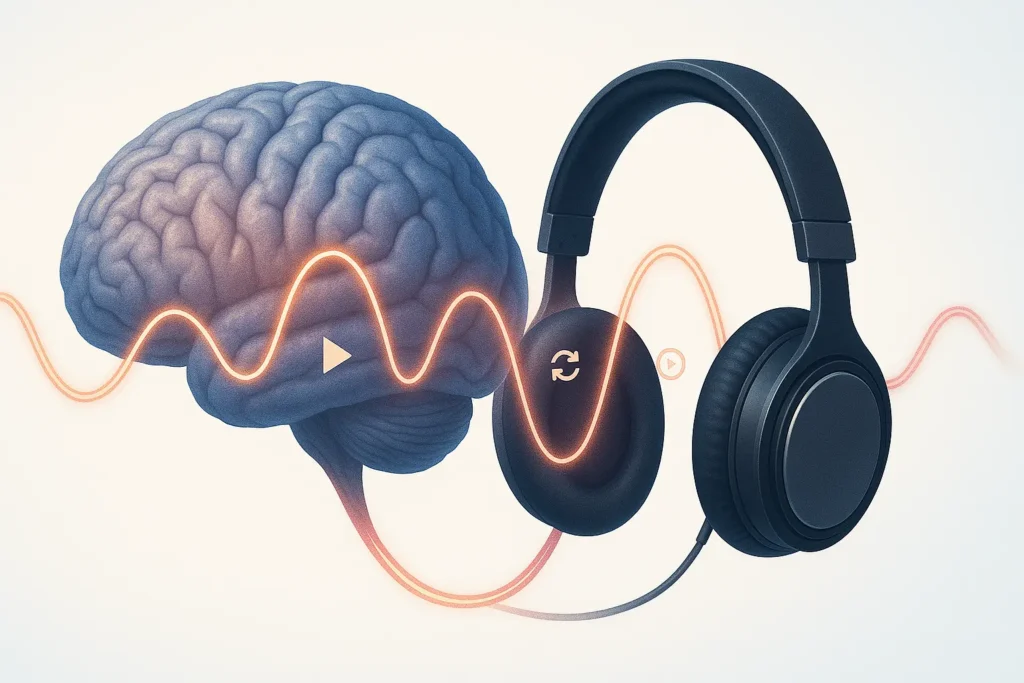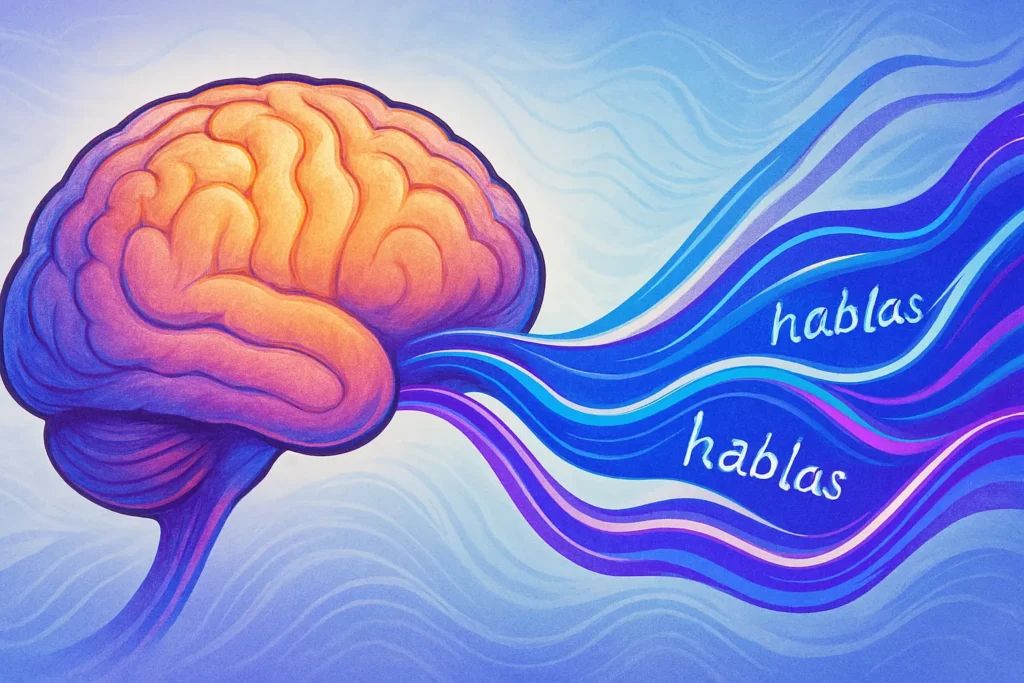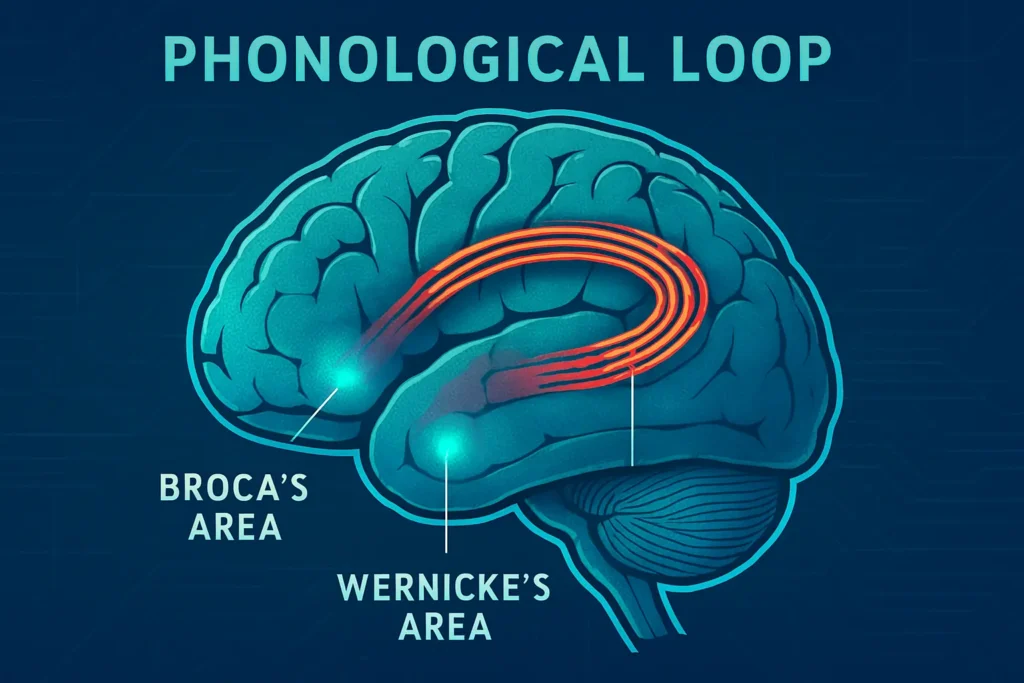Introduction
Learning a new language is a challenging yet rewarding experience, and achieving fluency is the ultimate goal. One of the most effective, yet underutilized, methods to accelerate fluency is listening to language forms on a continuous loop. This technique takes advantage of a key component of the human brain: the phonological loop. By understanding the neuroscience behind auditory repetition, we can make language acquisition faster, more intuitive, and more enjoyable.

Why Our Loop-Based Listening is Unique:
While many language learning platforms focus on grammar drills and flashcards, our method leverages neuroscience to enhance fluency. Our unique loop-based audio feature is designed to activate your brain’s phonological loop, helping you internalize verb forms naturally and effortlessly. Unlike traditional methods that rely on rote memorization of rules, loop-based listening mimics how native speakers acquire language—by hearing patterns repeatedly in context.

Why Loop-Based Listening Works:
- Activates the phonological loop
- Builds natural fluency
- Improves pronunciation through repetition
- Reduces cognitive load
The Phonological Loop: Your Brain’s Built-In Language Trainer
The phonological loop is a critical component of working memory, playing a vital role in processing and temporarily storing auditory information. It consists of two main components:
- Phonological Store: Holds sound-based information for a short period.
- Articulatory Rehearsal Mechanism: Repeats and refreshes stored information to keep it active.
When learning a new language, especially a second language, the phonological loop helps learners master pronunciation, sentence structures, and the rhythm of speech. Instead of relying solely on conscious memorization, the brain naturally absorbs patterns through auditory exposure. This process aligns with the way native speakers learn to speak—by hearing language in context repeatedly[1].

Why Listening on a Loop Works for Language Learning
Research in cognitive neuroscience indicates that repeated auditory exposure significantly enhances memorization and recall[2]. By continuously hearing natural language patterns, the brain encodes these sounds efficiently, moving them from short-term to long-term memory. This method supports developing a level of fluency where words and phrases “just sound right”[3].
Why “Just Sounds Right” Matters
Fluent speakers don’t think about grammar rules during conversation. Instead, the correct forms “just sound right.” Achieving this level of automaticity is essential for speaking confidently and without strain. Loop-based listening supports this natural fluency by embedding language patterns directly into the brain’s auditory processing system[4].
Key Benefits of Loop-Based Listening:
- Faster Recall: Learners instinctively remember forms without needing to think about grammar rules.
- Reduced Cognitive Load: Listening-based learning is less mentally taxing compared to rote memorization[5].
- Improved Pronunciation: Hearing natural pronunciation repeatedly helps learners internalize correct sounds[6].
- Long-Term Retention: Frequent exposure ensures that language patterns are deeply embedded in memory[7].
- Natural Fluency: Over time, learners develop an intuitive sense of correctness, allowing them to speak confidently and fluidly[8].

Applying the Phonological Loop to Learning Verb Conjugations
One of the most challenging aspects of learning Spanish is mastering verb conjugations. Traditional methods often involve memorizing verb endings and conjugation rules, which can overwhelm the working memory. In contrast, our looping audio feature presents conjugated forms repeatedly, allowing learners to internalize the correct sounds naturally.
For example, hearing the conjugated forms of “hablar”—”yo hablo,” “tú hablas,” “él/ella habla”—on a continuous loop helps the brain recognize and retain the correct conjugation pattern without explicit rule memorization. This approach helps learners reach the point where the correct conjugation “just sounds right”—the hallmark of fluency[9].

Real-Life Application: The Looping Audio Feature
On our conjugation pages, we’ve implemented an innovative audio feature that loops verb conjugations continuously once the user clicks play. This feature is unique among language learning resources and is designed to optimize the way learners internalize verb forms. By positioning the audio at the top of each page and incorporating insights from neuroscience, we ensure that our content is not only unique but also genuinely beneficial for language learners.
Backed by Research
Multiple studies have shown that the phonological loop plays a vital role in language acquisition, particularly in bilingualism and second-language learning[10]. For example, research published in the Journal of Memory and Language demonstrates that auditory repetition enhances recall and automaticity in language production[11]. Incorporating these insights into our methodology sets us apart as a forward-thinking language learning platform.
Try Loop-Based Listening for Yourself
Experience the power of loop-based listening on our conjugation pages. Our audio feature is available for these Spanish tenses and moods:
- Present Tense Conjugations
- Preterite (Past) Tense Conjugations
- Imperfect Tense Conjugations
- Subjunctive Mood Conjugations
- Imperative Mood (Affirmative Commands) Conjugations
- Future Tense Conjugations
Start with some of our most popular verbs:
Key Takeaways
- The Phonological Loop Connection: Loop-based listening leverages your brain’s natural language learning mechanism—the phonological loop—to improve language acquisition.
- Natural Fluency: This technique promotes intuitive language understanding without explicit grammar memorization.
- Cognitive Benefits: Loop-based listening reduces mental strain while supporting long-term retention and improved pronunciation.
- Practical Application: Our conjugation pages implement this research-backed approach, making it easier for you to master Spanish verb forms.
Conclusion
Loop-based listening is an innovative, research-backed method to accelerate fluency. By prioritizing the phonological loop in our learning strategy, we make language acquisition more natural and efficient. Explore our conjugation pages to experience how listening on a loop can transform your language learning journey.
References
- Baddeley, A., Gathercole, S., & Papagno, C. (1998). The phonological loop as a language learning device. Psychological Review, 105(1), 158–173. ↩
- Cuddy, L. L., & Jacoby, L. L. (1982). Repetition effects in auditory and visual recognition. Canadian Journal of Psychology, 36(3), 469–477. ↩
- Service, E. (1992). Phonology, working memory, and foreign-language learning. The Quarterly Journal of Experimental Psychology, 45(1), 21–50. ↩
- Acheson, D. J., & MacDonald, M. C. (2009). Verbal working memory and language production: Common approaches to the serial ordering of verbal information. Psychological Bulletin, 135(1), 50–68. ↩
- Gathercole, S. E., & Baddeley, A. D. (1989). Evaluation of the role of phonological STM in the development of vocabulary in children: A longitudinal study. Journal of Memory and Language, 28(2), 200–213. ↩
- Hebb, D. O. (1961). Distinctive features of learning in the higher animal. In J. F. De La Fresnaye (Ed.), Brain Mechanisms and Learning (pp. 37–46). Oxford: Blackwell. ↩
- Kerpics, M., & Kormos, J. (2020). Phonological memory training and its effect on second language grammar learning. Second Language Research, 36(3), 439–465. ↩
- Lee Swanson, H., & Orosco, M. J. (2019). The phonological loop and dual language learning: Do growth differences exist across languages? Bilingual Research Journal, 42(2), 192–210. ↩
- Baddeley, A. D. (2003). Working memory and language: An overview. Journal of Communication Disorders, 36(3), 189–208. ↩
- Papagno, C., Valentine, T., & Baddeley, A. (1991). Phonological short-term memory and foreign-language vocabulary learning. Journal of Memory and Language, 30(3), 331–347. ↩
- Trofimovich, P., & Gatbonton, E. (2006). Repetition and focus on form in processing L2 Spanish words: Implications for pronunciation instruction. The Modern Language Journal, 90(4), 519–535. ↩
